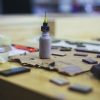Liquid copper. Image JB Labrune You employed a rather unusual material, some kind of liquid copper? Can you explain it its role in your prototype? Some of my colleagues and friends (Leah Buechley, Hannah Perner-Wilson, Nadya Peek) are the best in collecting nice stuff that conduct electricity like all kind of liquid suspensions, animal exoskeletons or felted particles… I realised different prototypes of circuits boards using liquid copper since with silver, this metal is a very good conductor of electricity, which we like in general (except if you want to make resistive sensors). The particular one used in the project you mentioned is the moderately cheap CuPro-CoteTM paint from LessEMF, a website specialised in anti-abduction garments, well known from electronic textile folks since it proposes all kind of nice conductive fabric based on copper or silver with beautiful and strange names like Flectron or Zelt. Because it is almost entirely composed of copper, this paint is in principle not dangerous for health since copper can even be moderately ingerated (in principle :). Leah Buechley and her research group frequently use it to make paper electronics by directly painting circuits on paper with such paints. My idea was to use a fast CNC machine (like a laser cutter for example) to quickly draft electronic objects since this kind of machines are precise and good at repetitive tasks, and then let a human finish them since they are usually very good at the inverse, therefore creating an interesting tension between repeatability and originality. The boards were made out of different materials with various hydrophobic or hydrophilic surfaces (PMMA, Wood, BioComposites) inviting the liquid copper to go into machine cut channels according to precise paths. The precision of the CNC machines I used allowed to create rather compact circuits at SOIC or even QFN pitch (which corresponds to most of artistic grade electronic components) but also, and interestingly enough to develop precise high frequency antennas or very precise solenoids (electromagnets) by simple depositions, which led me for example to create monolithic speakers from wood and copper in a following project. (via DIY Transducers – we make money not art)
